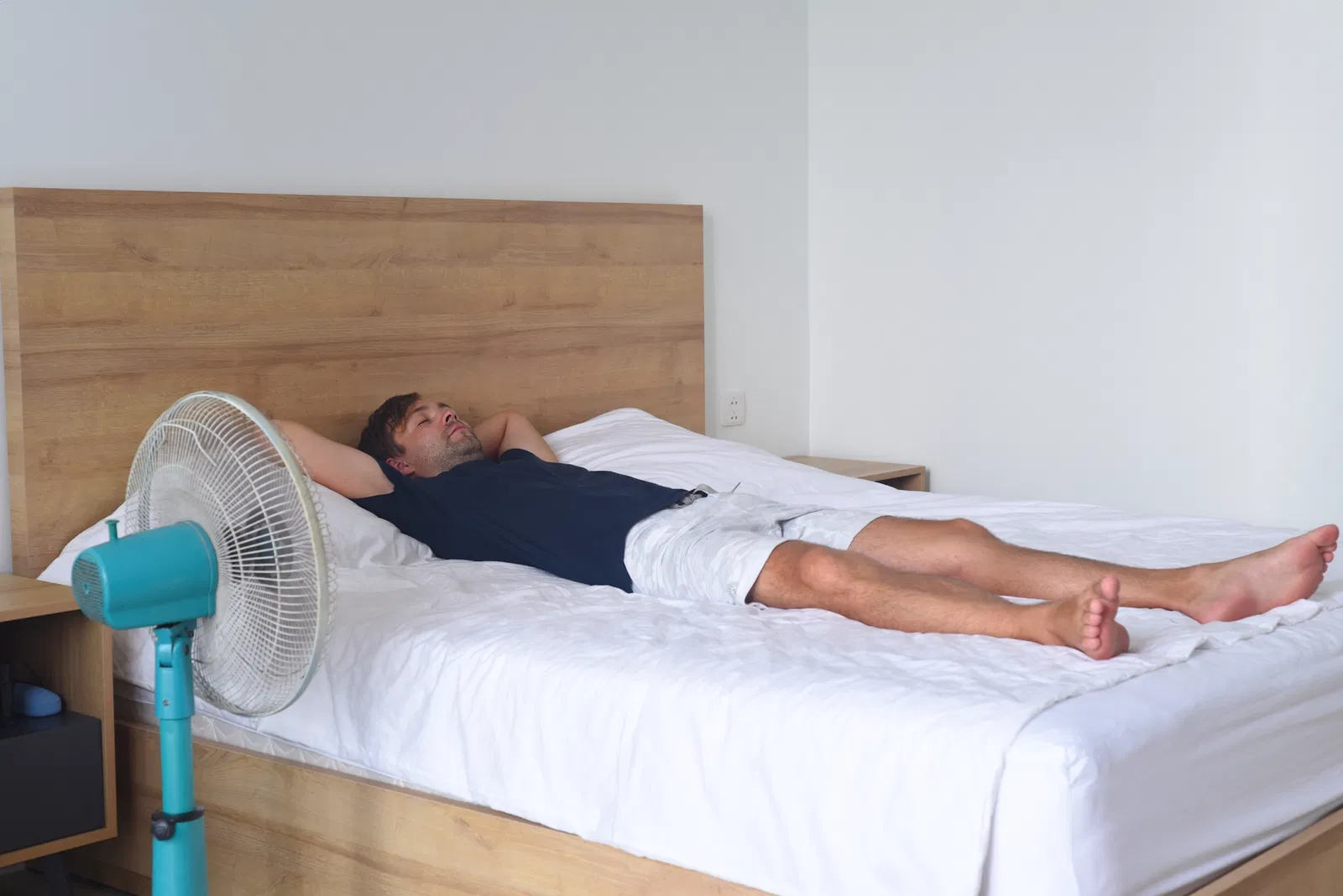The Hidden Health Risks of Direct Fan Exposure During Sleep for Senior Adults: A Comprehensive Guide
As temperatures rise and comfort becomes a priority for quality sleep, many older adults turn to electric fans as an accessible and cost-effective solution for maintaining cool sleeping conditions. The gentle hum and cooling breeze provided by bedside fans can indeed offer relief during warm nights, making them a popular choice among seniors seeking better sleep comfort. However, recent health considerations have highlighted that positioning a fan to blow directly onto the face during sleep may present unexpected health risks, particularly for older adults whose physiological systems may be more vulnerable to environmental stressors.
The practice of sleeping with direct fan airflow, while seemingly harmless, can lead to a cascade of health issues that may not be immediately apparent but can significantly impact overall well-being and sleep quality. Understanding these potential risks and implementing safer alternatives becomes crucial for maintaining both comfort and health during the sleeping hours.
The Physiological Vulnerabilities of Aging
Before examining the specific risks associated with direct fan exposure, it is essential to understand how the aging process affects the body’s ability to cope with environmental factors. As individuals age, several physiological changes occur that can increase susceptibility to the adverse effects of constant airflow exposure during sleep.
The skin becomes thinner and loses moisture more readily, making it more prone to dryness and irritation. Additionally, the production of natural lubricants in the eyes and nasal passages decreases with age, reducing the body’s ability to maintain adequate moisture levels in these sensitive areas. The immune system also undergoes changes that can make older adults more susceptible to respiratory irritation and slower to recover from minor health disturbances.
These age-related changes create a foundation of vulnerability that can be exacerbated by environmental factors such as direct fan airflow, making what might be a minor inconvenience for younger individuals a more significant health concern for seniors.
Primary Health Risks Associated with Direct Fan Exposure
1. Respiratory System Dryness and Irritation
One of the most immediate and concerning effects of sleeping with a fan pointed directly at the face involves the drying effect on the respiratory system. The constant flow of air across the nasal passages, throat, and airways can significantly reduce moisture levels in these delicate tissues, leading to a range of uncomfortable and potentially problematic symptoms.
The nasal passages, which naturally produce mucus to trap particles and maintain moisture, can become excessively dry when exposed to continuous airflow. This drying effect can lead to nasal congestion, irritation, and in severe cases, nosebleeds. The reduction in natural moisture can also compromise the nose’s ability to filter and humidify incoming air, potentially allowing more irritants and allergens to reach the lower respiratory system.
The throat and upper airway are similarly affected by direct fan exposure. The constant air movement can cause the throat to become dry and irritated, leading to a scratchy feeling, persistent cough, or difficulty swallowing upon waking. For seniors who may already have compromised respiratory function or reduced saliva production, these effects can be particularly pronounced and uncomfortable.
2. Ocular Discomfort and Dry Eye Syndrome
Direct fan airflow can significantly impact eye health and comfort, particularly for older adults who may already be experiencing age-related changes in tear production. The constant movement of air across the eyes increases tear evaporation, leading to dry eye symptoms that can range from mild discomfort to significant irritation.
Dry eye syndrome, already common among older adults due to hormonal changes and reduced tear production, can be exacerbated by the drying effect of direct fan airflow. Symptoms may include burning, stinging, or gritty sensations in the eyes, excessive tearing as the eyes attempt to compensate for dryness, and blurred vision that may persist into the morning hours.
The delicate tissues of the eyelids and surrounding areas can also become irritated by constant air exposure, leading to redness, inflammation, and general discomfort that may interfere with sleep quality and daily activities.
3. Musculoskeletal Stiffness and Discomfort
The cooling effect of direct fan airflow can cause muscle tissues to contract and stiffen, particularly in the neck, shoulders, and upper back regions. This physiological response to cooler temperatures can lead to significant discomfort and reduced mobility upon waking, issues that may be particularly problematic for seniors who already experience joint stiffness or muscle tension.
The neck and shoulder muscles, which are already prone to tension due to sleeping positions and age-related changes, can become notably stiff when exposed to direct cool airflow throughout the night. This stiffness may manifest as reduced range of motion, pain with movement, or a general feeling of muscle tightness that can persist throughout the day.
For older adults with existing conditions such as arthritis, fibromyalgia, or other musculoskeletal disorders, the additional stiffness caused by direct fan exposure can significantly impact daily functioning and quality of life.
4. Respiratory Function Complications
Beyond simple dryness and irritation, direct fan exposure can pose more serious risks to respiratory health, particularly for seniors with pre-existing breathing conditions. The cool, dry air can act as a trigger for various respiratory issues, potentially causing or exacerbating conditions such as asthma, chronic bronchitis, or other chronic obstructive pulmonary diseases.
The sudden temperature change and increased air movement can cause the airways to constrict, leading to difficulty breathing, wheezing, or chest tightness. For individuals with sensitive respiratory systems, these effects can be particularly pronounced and may require medical intervention.
Additionally, the drying effect on the respiratory passages can reduce the effectiveness of the body’s natural defense mechanisms, potentially increasing susceptibility to respiratory infections or exacerbating existing conditions.
5. Sleep Quality Disruption
While the white noise generated by fans can be beneficial for some individuals, the direct airflow can actually disrupt the body’s natural temperature regulation mechanisms, leading to fragmented or poor-quality sleep. The constant air movement can cause micro-awakenings that may not be consciously noticed but can significantly impact sleep architecture and restorative processes.
The body’s natural temperature fluctuations during sleep cycles can be disrupted by constant external cooling, potentially interfering with the deep sleep stages that are crucial for physical and cognitive restoration. This disruption may manifest as daytime fatigue, reduced cognitive function, or a general feeling of not being well-rested despite spending adequate time in bed.
Safer Alternatives and Best Practices
Strategic Fan Positioning
Rather than pointing the fan directly at the sleeping area, consider positioning it to create indirect airflow that circulates air throughout the room without creating a direct stream toward the face or body. Oscillating fans can be particularly effective for this purpose, as they distribute air movement more evenly throughout the space.
Ceiling fans, when available, often provide better air circulation without the concentrated airflow that can cause the problems associated with direct exposure. These fans can create a gentle, room-wide air movement that promotes comfort without the risks of targeted airflow.
Environmental Modifications
If dry air is a concern, consider using a humidifier in conjunction with fan use to maintain appropriate moisture levels in the sleeping environment. This can help counteract the drying effects of air movement while still providing the comfort benefits of improved air circulation.
Adjusting room temperature through other means, such as air conditioning or opening windows during cooler parts of the day, can reduce the need for direct fan exposure while maintaining comfortable sleeping conditions.
Personal Protective Measures
For individuals who find fan use necessary for comfort, wearing appropriate sleepwear that provides some protection from direct airflow can help mitigate risks. Light, breathable fabrics that cover the neck and upper body can provide a barrier against direct air exposure while maintaining comfort.
Eye protection, such as a sleep mask, can help prevent dry eye symptoms while still allowing for the benefits of air circulation in the room.
When to Seek Medical Attention
Seniors who experience persistent symptoms such as chronic dry eyes, ongoing respiratory irritation, or significant muscle stiffness after sleeping with fan exposure should consult with healthcare providers. These symptoms may indicate underlying conditions that require attention or may suggest the need for alternative cooling strategies.
Conclusion
While fans can provide valuable comfort during warm sleeping conditions, the practice of direct fan exposure during sleep poses several health risks that are particularly relevant for older adults. The physiological changes that accompany aging can make seniors more vulnerable to the adverse effects of constant airflow, including respiratory irritation, dry eye symptoms, muscle stiffness, and sleep quality disruption.
By understanding these risks and implementing safer alternatives, older adults can continue to enjoy comfortable sleeping conditions while protecting their health and well-being. The key lies in finding the right balance between comfort and safety, utilizing air circulation strategies that provide cooling benefits without the direct exposure that can lead to health complications.
Making informed decisions about nighttime comfort measures represents an important aspect of healthy aging, allowing seniors to maintain quality sleep while minimizing unnecessary health risks. Through careful consideration of fan positioning, environmental modifications, and personal protective measures, older adults can create sleeping environments that support both comfort and health throughout the night.

Sophia Rivers is an experienced News Content Editor with a sharp eye for detail and a passion for delivering accurate and engaging news stories. At TheArchivists, she specializes in curating, editing, and presenting news content that informs and resonates with a global audience.
Sophia holds a degree in Journalism from the University of Toronto, where she developed her skills in news reporting, media ethics, and digital journalism. Her expertise lies in identifying key stories, crafting compelling narratives, and ensuring journalistic integrity in every piece she edits.
Known for her precision and dedication to the truth, Sophia thrives in the fast-paced world of news editing. At TheArchivists, she focuses on producing high-quality news content that keeps readers informed while maintaining a balanced and insightful perspective.
With a commitment to delivering impactful journalism, Sophia is passionate about bringing clarity to complex issues and amplifying voices that matter. Her work reflects her belief in the power of news to shape conversations and inspire change.
